Ford Taurus Rear Brake Pads
Replacement Guide
How to change the rear disc brake pads on
a 6th generation 2010 to 2014 Ford Taurus sedan with photo illustrated steps.
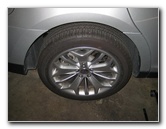 2013 Taurus Rear Wheel |
 Slightly Loosen 5 Lug Nuts |
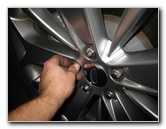 Raise Vehicle & Spin Off Nuts |
| This
automotive maintenance tutorial was specifically written to assist
owners of the 6th generation (2010, 2011, 2012, 2013 & 2014) Ford
Taurus sedan in changing the rear disc brake pads. Owners of other Ford, Lincoln and Mercury vehicles with similar rear brake hardware such as the Fiesta, Fusion, Focus, C-Max, Mustang, Escape, Transit Connect, Explorer, Edge, Expedition, Flex, MKS, MKZ, MKT, MKX, Navigator, Milan, Grand Marquis, Mariner and Mountaineer may also find these DIY instructions to be helpful. The items needed to complete this procedure include a lug nut wrench, a floor jack, two jack stands, a 13mm socket, a ratcheting wrench, a disc brake piston tool (Lisle # 28600), an extension bar, a tube of brake parts lubricant grease and a new set of rear brake pads. A few compatible sets of new rear brake pads include the following with their part numbers: ACDelco 17D1377CH, Wagner QC1377 or ZD1377, Raybestos ATD1377C, Bosch BC1377, Bendix D1377, Monroe CX1377, Power Stop 16-1377, Motorcraft BR-1377 and Akebono # ACT1377. |
||
|
|
||
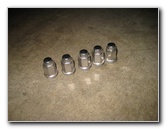 5 Lug Nuts Removed |
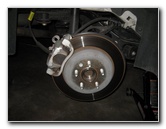 Caliper, Bracket, Rotor |
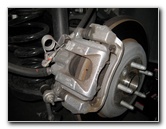 Rear Brake Caliper |
| The first two steps
are to park the vehicle on a level surface and then chock the front wheels
to prevent it from moving. Slightly loosen the 5 lug nuts on the rear wheel by turning them counter clockwise with the lug nut wrench. I prefer to work on one side of the vehicle at a time for extra safety. Raise the rear of the car with the floor jack and securely support it with at least two jack stands. Spin off the 5 lug nuts and set them aside in a safe place. Pull off the rear wheel to reveal the rotor, bracket, caliper and suspension. |
||
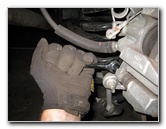 Loosen Lower 13mm Bolt |
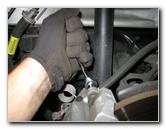 Loosen Upper Caliper Bolt |
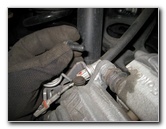 Spin Out Upper Caliper Bolt |
| The caliper is held
in place to the bracket by two bolts on the rear side of the caliper facing
towards the center of the vehicle. Loosen the lower caliper bolt by turning it clockwise (as seen from the outside of the vehicle) with the 13mm socket and ratcheting wrench. Then loosen the upper caliper bolt by turning it clockwise (as seen from the outside of the car) with the 13mm socket and ratcheting wrench. |
||
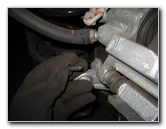 Remove Lower 13mm Bolt |
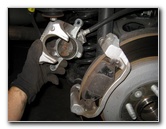 Pull Off Rear Brake Caliper |
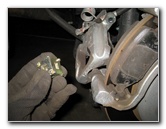 Lisle Disc Brake Piston Tool |
| Spin out the two
caliper bolts and set them aside in a safe place. Lift the caliper out of the bracket and off the old pads. In order for the caliper to fit over the thicker new pads, the caliper piston will need to be retracted backwards. The 6th gen Taurus is equipped with "screw-in" type rear caliper pistons that need to be turned back with a special tool such as the Lisle # 28600. You may also be able to just use a pair of needle nose pliers to rotate the piston back in to the caliper. |
||
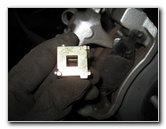 Test Fit Sides of Tool |
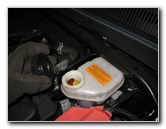 Twist Off Brake Fluid Cap |
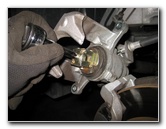 Turn Back Caliper Piston |
| Test fit each side
of your disc brake piston tool to find the side that has the best grip on
the rear caliper piston.
On this 2013 Taurus, the side with 2 "nubs" or pegs fit the best. Move to the right rear area of the engine bay (closest to the driver's seat) and twist off the black plastic brake fluid reservoir cap in the counter clockwise direction. Attach the piston tool to the extension bar and a ratcheting wrench. Slowly turn back the caliper piston in the clockwise direction until it is flush with its rubber dust boot. Replace the brake fluid cap as soon as possible since brake fluid is hygroscopic (absorbs moisture from the air). |
||
|
|
||
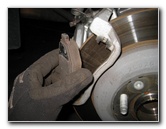 Pull Out Outer Pad |
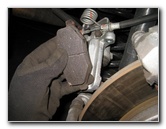 Remove Old Inner Pad |
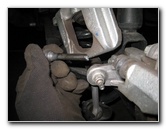 Pull Out Caliper Slider Pins |
| Pull the two old
brake pads out of the caliper bracket and discard them. I usually buy the Wagner ThermoQuiet QC1377 brake pads since they have great reviews on Amazon. I also like how they don't require any backing plates, shims or disc brake quiet gel due to the built in insulators. In order for the caliper to work smoothly, the two caliper slider pins need to be well lubricated. Pull the upper and lower caliper slider pins out of their rubber dust boots on the back side of the bracket. Apply a thin layer of brake parts lubricant to each pin before pushing them back in to their rubber dust boots. Thoroughly clean off the brake rotor, caliper bracket, brake caliper assembly and the lug nut studs with brake parts cleaner spray. Do not use compressed air or blow with your mouth to clean off the brake parts since breathing in brake dust can be harmful to your health. Brake dust may be carcinogenic (causes cancer) if inhaled.
To remove the existing rotors and install new ones, remove the two bolts on the rear of the caliper bracket that attach it to the steering knuckle. Then loosen the old rotor with a rubber mallet, pull it off, and slide the new one in its place. Apply a thin layer of brake caliper grease to any area where there is metal to metal contact such as the outer lip of the caliper pistons. Do not apply brake parts grease to the friction surface of the new pads or to the face of the rotor. |
||
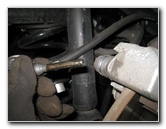 Lubricate & Replace Pins |
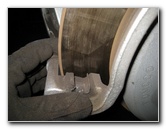 Replace Pad Abutment Clips |
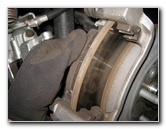 Install New Inner Pad |
| If your set of new rear brake pads included new brake hardware, pull out the old metal pad abutment or "anti-rattle" clips from the top and bottom of the bracket before installing the new ones in their place. | ||
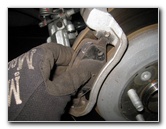 Install New Outer Pad |
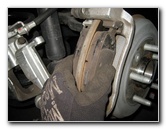 Push Pads Against Rotor |
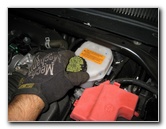 Replace Brake Fluid Cap |
| Install the new
pads in to the bracket and push them flush against the rotor. If you haven't done so already, replace the brake fluid reservoir cap by twisting it on in the clockwise direction. |
||
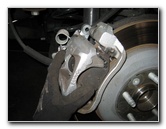 Replace Rear Brake Caliper |
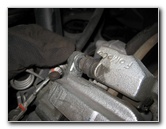 Spin In Upper Caliper Bolt |
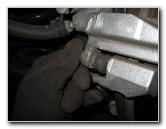 Replace Lower Caliper Bolt |
| Lower the rear
caliper down over the new pads and in to the bracket. Line up the bolt holes in the caliper with the corresponding holes in the caliper slider pins within the bracket. Spin in the two caliper bolts in the counter clockwise direction by hand a few turns to prevent them from becoming cross threaded. |
||
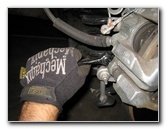 Tighten Counter Clockwise |
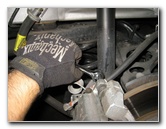 Tighten Upper 13mm Bolt |
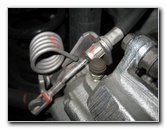 Rubber Valve Cap |
|
Tighten the two caliper bolts by turning them counter clockwise (as seen from the outside of the vehicle) with the 13mm socket and ratcheting wrench to just past hand tight or about 25 ft-lbs of torque. If your brake pedal previously felt soft or spongy, the brake fluid may be contaminated with water or the brake lines may contain some air bubbles. It would be best to bleed the brake lines at this time in order to flush out the old fluid and replace it with fresh DOT3 brake fluid. For more on this topic, check out my Brake Line Fluid Bleeding With An Assistant DIY Guide or alternatively the Brake Line Fluid Bleeding With A Power Bleeder Guide. The brake fluid bleeder valve is located underneath a rubber cap on the back side of the caliper near the upper caliper bolt. |
||
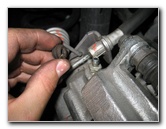 Brake Fluid Bleeder Valve |
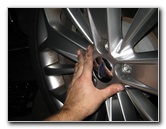 Replace Rear Wheel |
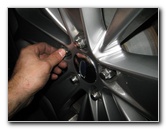 Spin On 5 Lug Nuts |
| Replace the rear wheel and spin on the 5 lug nuts in the clockwise direction. | ||
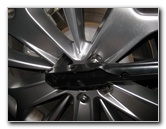 Slightly Tighten Clockwise |
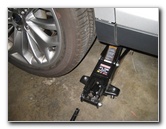 Lower Rear of Vehicle |
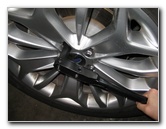 Torque To 100 ft-lbs |
| Slightly tighten
the 5 lug nuts in a criss-cross or "star" pattern with the tire iron. Lower the vehicle from the jack stands using the floor jack until the tire holds enough weight to keep it from spinning. Continue progressively tightening the 5 lug nuts in a "criss cross" or "star" pattern to about 1/4 turn past hand tight or about 100 ft-lbs of torque. It would be best to use a torque wrench or an impact wrench with a torque stick to properly tighten the lug nuts. Sit in the driver's seat of the vehicle and firmly press the brake pedal a few times to restore the brake line pressure. Check the brake fluid in the reservoir and verify that it is at the proper level. If it is low, add some new DOT 4 fluid. To break in your new brake pads, just drive normally for the first few hundred miles while trying to avoid any hard or "panic" stops which may glaze over the new pads and cause them to be noisy and/or not perform as well. It's also a good idea to regularly check your driveway for drops of brake fluid which may indicate a leak, check the brake fluid level in the reservoir, and also verify that the lug nuts are still tight. For more, please check out my other
Ford Taurus DIY Repair Guides. |
||
| If you found this guide to be helpful,
please consider making a small donation by clicking on the PayPal.com
"Donate" button located to the right of this paragraph. Thank you!
(Note: I am not a registered charity. Donations are not tax deductible.) |

